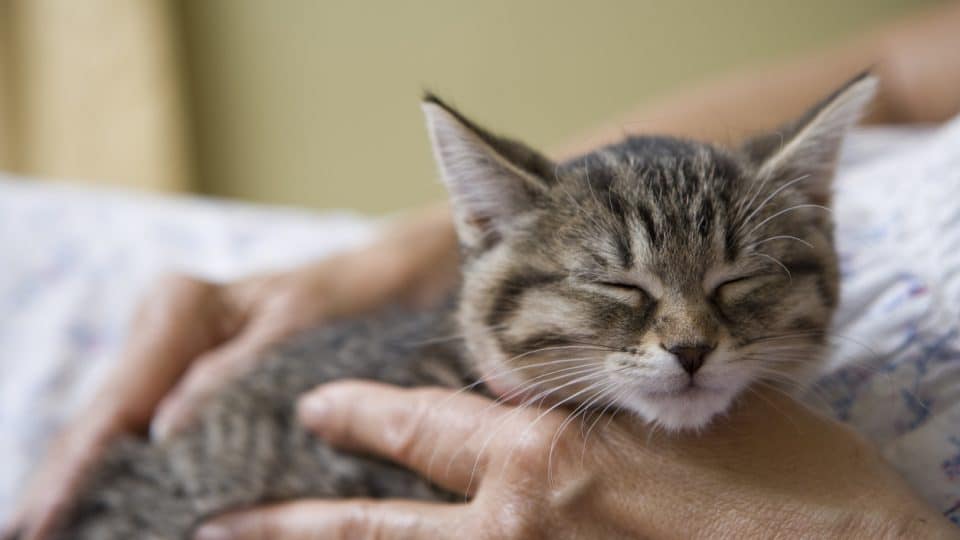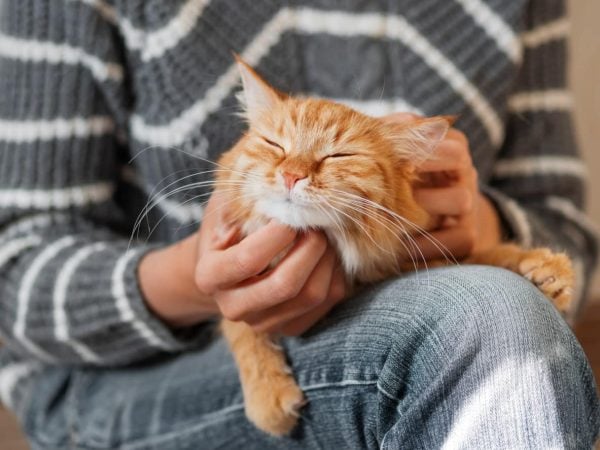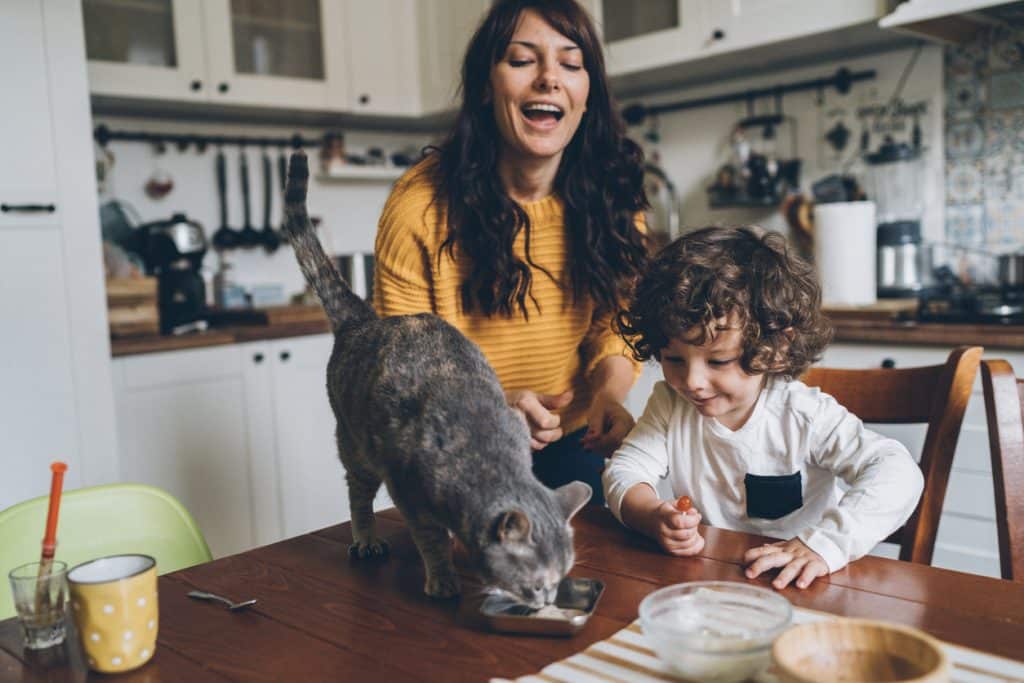A cat purring is a way to communicate with people and other cats. Purring can express positive emotions like happiness and affection, but it also helps cats self-soothe when they experience fear, anxiety, or pain.
Since purring can happen as a sign of stress or pain as well as contentment, it’s important to consider the context to decipher the reasons for your cat’s purr, explains Laura Cassiday, certified cat behaviour consultant, Fear Free™ certified professional trainer, and founder of Pawsitive Vibes Cat Behavior & Training.
Your cat’s purring can range from a quiet hum to an engine-like rumble—and translating it can be as simple as observing how and where it happens!
Read on to learn how to decode your cat’s purring, with help from experts.
How Do Cats Purr?
Purring may seem to come from deep within your cat, but the purr begins in their head! Experts believe neural oscillations, or brainwaves in the central nervous system, trigger the purr.
Then, when your cat inhales and exhales, the muscles of their larynx, or voice box, dilate and constrict the area around their vocal cords. This causes air to vibrate over the laryngeal muscles, creating the purr.
Why Cats Purr When They Feel Happy and Safe
Purring as an expression of happiness and safety starts at a young age. Kittens are born blind and deaf, and their mother’s purr helps guide them to food. While nursing, a mother cat will continue purring to soothe and bond with the kittens. Instinctively, kittens purr back at her and their littermates.
“Because humans are a vocal species, purring sticks out to us more than some of the other ways cats communicate happiness,” Cassiday says.
Purring cats who are happy and relaxed will show body language that reflects that. For instance, a cat sprawled out on her side in the sun is probably purring because she’s happy. Other signs of contentment include slow blinking, headbutting, or rubbing up against you!
Here’s why your cat might be purring:
1. They’re showing affection
Cats purr to express love for their people. You might notice your cat’s purring kick into high gear when they’re cuddling or kneading a soft surface like a cosy blanket or your lap.
Of course, cats don’t purr only to communicate and connect with humans. They may also purr with feline companions to bond and show affection and trust.
Adult cats will often purr when they’re near or touching another cat, Cassiday says, such as during mutual grooming or “pillowing”—using another cat as a pillow.
2. They’re enjoying your touch
Cats often purr while cuddling or curled up on their favourite human. This type of purring generally means your cat is enjoying your company and your touch. Think of it as your cat’s way of saying, “This makes me feel good!” and “I like being near you.”
3. They’re communicating their needs
A cat who wants something usually won’t be shy about letting you know.
“A purr that’s asking for something, like food, tends to be much higher-pitched than other purrs and is combined with a meow-type sound,” says Dr. Megan Conrad, a veterinarian with WellHaven Pet Health.
Cats who want more one-on-one time with you may also purr to communicate those needs. For example, your cat might weave between your legs, holding their tail high and rubbing against you, says Amanda Caron, certified cat behaviour consultant and owner of Frisky Feline Behavior Counseling.
4. They’re having a good time
“We typically think of a cat sitting in your lap or cuddling when they’re purring, but it’s not just limited to those times,” Cassiday says.
Cats and kittens might purr while doing anything they like—playing, running around the house with other cats, or getting a mental and physical workout by clicker training with you. Some cats may also purr while eating.
Solo cats will also sometimes purr while they’re playing by themselves or eating.
Why Cats Purr When They’re Stressed or Unwell
Purring isn’t just a sign of positive feelings. Cats also purr when in pain, while giving birth, and when they’re dying.
“Purring can actually help a cat feel better when going through painful situations because it releases endorphins,” explains Dr. Sabrina Kong, a veterinarian at We Love Doodles.
The low frequency of a cat’s purr has also been shown to decrease stress levels, lower blood pressure, and ease laboured breathing in cats, Dr. Kong adds.
Other body language signs like ear position, tail movement, and eyes can help you find out if your cat is purring because they’re stressed or sick, Caron says.
Here’s why a sick cat might purr:
1. To self-soothe
Ever wondered why your cat purrs at the vet? Purring eases a cat’s nerves and helps them deal with anxiety, so it’s not unusual to catch a cat purring during a stressful situation.
“Purring can be a self-soothing behaviour, similar to when humans listen to soft music while studying or take deep breaths to help them focus,” Cassiday says.
2. To ease pain
“Purring might intensify during higher stress or stronger pain,” Cassiday says. For instance, their purring on the exam table may suddenly become louder when they receive a vaccine.
This isn’t a coincidence. The endorphins released by purring offer some pain relief, helping cats cope with discomfort.
Purring accompanied by low and flat “aeroplane” ears, a swishing or lashing tail, and squinting might mean your cat is in distress.
3. To heal themselves
Purring doesn’t just ease pain. It might also enhance a cat’s ability to heal. Some evidence suggests that vibration therapy at frequencies between 20 and 150 Hertz, a range a cat’s purr falls within, can speed up the healing of bones, tendons, and wounds.
“In some studies, a hum at this frequency appears to stimulate muscle and possibly bone healing, as well as pain relief,” Dr. Conrad says.
The healing power of purring isn’t limited to cats, either!
“Theoretically, a cat’s purr can stimulate healing in humans since their frequency corresponds with the one used in vibrational therapies,” Dr. Kong says.
Why Else Is My Cat Constantly Purring?
Your cat might also purr for a few other reasons:
1. Cats purr when in heat
While female cats in heat are notorious for noisy caterwauling and yowling, they also purr when trying to attract a mate.
Your unspayed cat may be in heat if she’s:
- Extra affectionate
- Enthusiastically rubbing her face and body all over everything
- Rolling around on the ground
- Raises her butt while she’s purring or being pet
2. Cats purr for human attention
Experts have also discovered that many cats make a unique purr-cry sound as a way to get your attention, which may not come as much of a surprise to anyone who lives with a cat.
This combination purr-cry sound occurs between 220 and 520 Hertz—nearly the same frequency as a human infant’s cry. In short, it’s very difficult for people to ignore, and your cat is probably very aware of this fact!
Of course, this doesn’t necessarily mean your cat has learned to manipulate you—just that they know a specific behaviour gives them a positive result, Dr. Conrad says.
Why Doesn’t My Cat Purr?
“Some cats don’t purr and that’s OK,” Caron says. “Lack of purring does not necessarily mean your cat is unhappy or unwell. They might just choose to communicate in different ways.”
If your cat’s purring goes into overdrive during a higher stress period, that’s normal, too. Take note if your cat shows any signs of pain or poor health, alongside increased purring, or if they suddenly stop purring entirely.
Dr. Conrad recommends paying attention to their eating, drinking, grooming, and everyday behaviour. “If you notice any unusual behaviour along with the purring, it’s a good idea to seek veterinary advice.”





